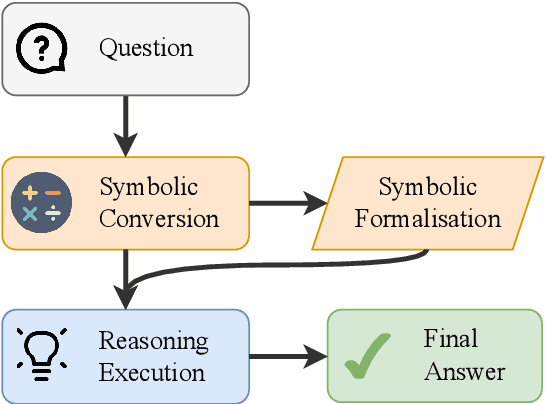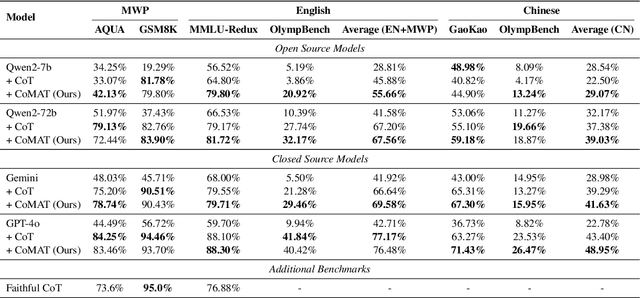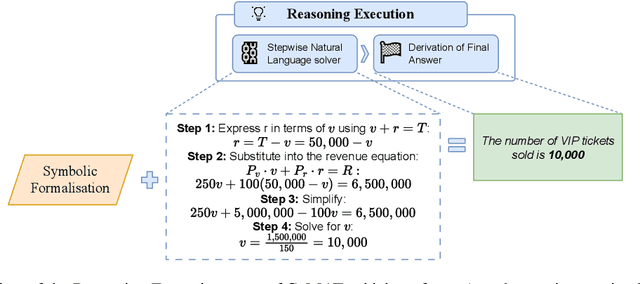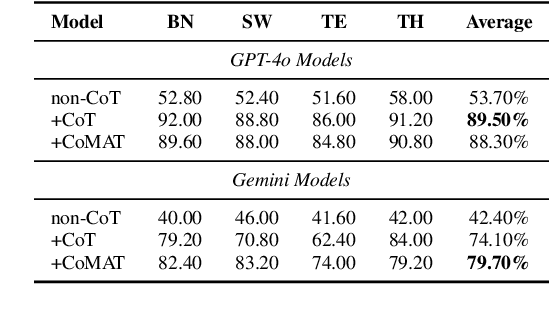Aryo Pradipta Gema
An Analysis of Decoding Methods for LLM-based Agents for Faithful Multi-Hop Question Answering
Mar 30, 2025Abstract:Large Language Models (LLMs) frequently produce factually inaccurate outputs - a phenomenon known as hallucination - which limits their accuracy in knowledge-intensive NLP tasks. Retrieval-augmented generation and agentic frameworks such as Reasoning and Acting (ReAct) can address this issue by giving the model access to external knowledge. However, LLMs often fail to remain faithful to retrieved information. Mitigating this is critical, especially if LLMs are required to reason about the retrieved information. Recent research has explored training-free decoding strategies to improve the faithfulness of model generations. We present a systematic analysis of how the combination of the ReAct framework and decoding strategies (i.e., DeCoRe, DoLa, and CAD) can influence the faithfulness of LLM-generated answers. Our results show that combining an agentic framework for knowledge retrieval with decoding methods that enhance faithfulness can increase accuracy on the downstream Multi-Hop Question Answering tasks. For example, we observe an F1 increase from 19.5 to 32.6 on HotpotQA when using ReAct and DoLa.
Self-Training Large Language Models for Tool-Use Without Demonstrations
Feb 09, 2025Abstract:Large language models (LLMs) remain prone to factual inaccuracies and computational errors, including hallucinations and mistakes in mathematical reasoning. Recent work augmented LLMs with tools to mitigate these shortcomings, but often requires curated gold tool-use demonstrations. In this paper, we investigate whether LLMs can learn to use tools without demonstrations. First, we analyse zero-shot prompting strategies to guide LLMs in tool utilisation. Second, we propose a self-training method to synthesise tool-use traces using the LLM itself. We compare supervised fine-tuning and preference fine-tuning techniques for fine-tuning the model on datasets constructed using existing Question Answering (QA) datasets, i.e., TriviaQA and GSM8K. Experiments show that tool-use enhances performance on a long-tail knowledge task: 3.7% on PopQA, which is used solely for evaluation, but leads to mixed results on other datasets, i.e., TriviaQA, GSM8K, and NQ-Open. Our findings highlight the potential and challenges of integrating external tools into LLMs without demonstrations.
Lost in Time: Clock and Calendar Understanding Challenges in Multimodal LLMs
Feb 07, 2025Abstract:Understanding time from visual representations is a fundamental cognitive skill, yet it remains a challenge for multimodal large language models (MLLMs). In this work, we investigate the capabilities of MLLMs in interpreting time and date through analogue clocks and yearly calendars. To facilitate this, we curated a structured dataset comprising two subsets: 1) $\textit{ClockQA}$, which comprises various types of clock styles$-$standard, black-dial, no-second-hand, Roman numeral, and arrow-hand clocks$-$paired with time related questions; and 2) $\textit{CalendarQA}$, which consists of yearly calendar images with questions ranging from commonly known dates (e.g., Christmas, New Year's Day) to computationally derived ones (e.g., the 100th or 153rd day of the year). We aim to analyse how MLLMs can perform visual recognition, numerical reasoning, and temporal inference when presented with time-related visual data. Our evaluations show that despite recent advancements, reliably understanding time remains a significant challenge for MLLMs.
DeCoRe: Decoding by Contrasting Retrieval Heads to Mitigate Hallucinations
Oct 24, 2024



Abstract:Large Language Models (LLMs) often hallucinate, producing unfaithful or factually incorrect outputs by misrepresenting the provided context or incorrectly recalling internal knowledge. Recent studies have identified specific attention heads within the Transformer architecture, known as retrieval heads, responsible for extracting relevant contextual information. We hypothesise that masking these retrieval heads can induce hallucinations and that contrasting the outputs of the base LLM and the masked LLM can reduce hallucinations. To this end, we propose Decoding by Contrasting Retrieval Heads (DeCoRe), a novel training-free decoding strategy that amplifies information found in the context and model parameters. DeCoRe mitigates potentially hallucinated responses by dynamically contrasting the outputs of the base LLM and the masked LLM, using conditional entropy as a guide. Our extensive experiments confirm that DeCoRe significantly improves performance on tasks requiring high contextual faithfulness, such as summarisation (XSum by 18.6%), instruction following (MemoTrap by 10.9%), and open-book question answering (NQ-Open by 2.4% and NQ-Swap by 5.5%).
Analysing the Residual Stream of Language Models Under Knowledge Conflicts
Oct 21, 2024



Abstract:Large language models (LLMs) can store a significant amount of factual knowledge in their parameters. However, their parametric knowledge may conflict with the information provided in the context. Such conflicts can lead to undesirable model behaviour, such as reliance on outdated or incorrect information. In this work, we investigate whether LLMs can identify knowledge conflicts and whether it is possible to know which source of knowledge the model will rely on by analysing the residual stream of the LLM. Through probing tasks, we find that LLMs can internally register the signal of knowledge conflict in the residual stream, which can be accurately detected by probing the intermediate model activations. This allows us to detect conflicts within the residual stream before generating the answers without modifying the input or model parameters. Moreover, we find that the residual stream shows significantly different patterns when the model relies on contextual knowledge versus parametric knowledge to resolve conflicts. This pattern can be employed to estimate the behaviour of LLMs when conflict happens and prevent unexpected answers before producing the answers. Our analysis offers insights into how LLMs internally manage knowledge conflicts and provides a foundation for developing methods to control the knowledge selection processes.
Steering Knowledge Selection Behaviours in LLMs via SAE-Based Representation Engineering
Oct 21, 2024



Abstract:Large language models (LLMs) can store a significant amount of factual knowledge in their parameters. However, their parametric knowledge may conflict with the information provided in the context -- this phenomenon, known as \emph{context-memory knowledge conflicts}, can lead to undesirable model behaviour, such as reliance on outdated or incorrect information. Analysing the internal activations of LLMs, we find that they can internally register the signals of knowledge conflict at mid-layers. Such signals allow us to detect whether a knowledge conflict occurs and use \emph{inference-time} intervention strategies to resolve it. In this work, we propose \textsc{SpARE}, a \emph{training-free} representation engineering method that uses pre-trained sparse auto-encoders (SAEs) to control the knowledge selection behaviour of LLMs. \textsc{SpARE} identifies the functional features that control the knowledge selection behaviours and applies them to edit the internal activations of LLMs at inference time. Our experimental results show that \textsc{SpARE} can effectively control the usage of either knowledge source to resolve knowledge conflict in open-domain question-answering tasks, surpassing existing representation engineering methods ($+10\%$) as well as contrastive decoding methods ($+15\%$).
CoMAT: Chain of Mathematically Annotated Thought Improves Mathematical Reasoning
Oct 14, 2024



Abstract:Mathematical reasoning remains a significant challenge for large language models (LLMs), despite progress in prompting techniques such as Chain-of-Thought (CoT). We present Chain of Mathematically Annotated Thought (CoMAT), which enhances reasoning through two stages: Symbolic Conversion (converting natural language queries into symbolic form) and Reasoning Execution (deriving answers from symbolic representations). CoMAT operates entirely with a single LLM and without external solvers. Across four LLMs, CoMAT outperforms traditional CoT on six out of seven benchmarks, achieving gains of 4.48% on MMLU-Redux (MATH) and 4.58% on GaoKao MCQ. In addition to improved performance, CoMAT ensures faithfulness and verifiability, offering a transparent reasoning process for complex mathematical tasks
A Comparative Study on Patient Language across Therapeutic Domains for Effective Patient Voice Classification in Online Health Discussions
Jul 23, 2024Abstract:There exists an invisible barrier between healthcare professionals' perception of a patient's clinical experience and the reality. This barrier may be induced by the environment that hinders patients from sharing their experiences openly with healthcare professionals. As patients are observed to discuss and exchange knowledge more candidly on social media, valuable insights can be leveraged from these platforms. However, the abundance of non-patient posts on social media necessitates filtering out such irrelevant content to distinguish the genuine voices of patients, a task we refer to as patient voice classification. In this study, we analyse the importance of linguistic characteristics in accurately classifying patient voices. Our findings underscore the essential role of linguistic and statistical text similarity analysis in identifying common patterns among patient groups. These results allude to even starker differences in the way patients express themselves at a disease level and across various therapeutic domains. Additionally, we fine-tuned a pre-trained Language Model on the combined datasets with similar linguistic patterns, resulting in a highly accurate automatic patient voice classification. Being the pioneering study on the topic, our focus on extracting authentic patient experiences from social media stands as a crucial step towards advancing healthcare standards and fostering a patient-centric approach.
Are We Done with MMLU?
Jun 07, 2024



Abstract:Maybe not. We identify and analyse errors in the popular Massive Multitask Language Understanding (MMLU) benchmark. Even though MMLU is widely adopted, our analysis demonstrates numerous ground truth errors that obscure the true capabilities of LLMs. For example, we find that 57% of the analysed questions in the Virology subset contain errors. To address this issue, we introduce a comprehensive framework for identifying dataset errors using a novel error taxonomy. Then, we create MMLU-Redux, which is a subset of 3,000 manually re-annotated questions across 30 MMLU subjects. Using MMLU-Redux, we demonstrate significant discrepancies with the model performance metrics that were originally reported. Our results strongly advocate for revising MMLU's error-ridden questions to enhance its future utility and reliability as a benchmark. Therefore, we open up MMLU-Redux for additional annotation https://huggingface.co/datasets/edinburgh-dawg/mmlu-redux.
Edinburgh Clinical NLP at MEDIQA-CORR 2024: Guiding Large Language Models with Hints
May 28, 2024Abstract:The MEDIQA-CORR 2024 shared task aims to assess the ability of Large Language Models (LLMs) to identify and correct medical errors in clinical notes. In this study, we evaluate the capability of general LLMs, specifically GPT-3.5 and GPT-4, to identify and correct medical errors with multiple prompting strategies. Recognising the limitation of LLMs in generating accurate corrections only via prompting strategies, we propose incorporating error-span predictions from a smaller, fine-tuned model in two ways: 1) by presenting it as a hint in the prompt and 2) by framing it as multiple-choice questions from which the LLM can choose the best correction. We found that our proposed prompting strategies significantly improve the LLM's ability to generate corrections. Our best-performing solution with 8-shot + CoT + hints ranked sixth in the shared task leaderboard. Additionally, our comprehensive analyses show the impact of the location of the error sentence, the prompted role, and the position of the multiple-choice option on the accuracy of the LLM. This prompts further questions about the readiness of LLM to be implemented in real-world clinical settings.
 Add to Chrome
Add to Chrome Add to Firefox
Add to Firefox Add to Edge
Add to Edge